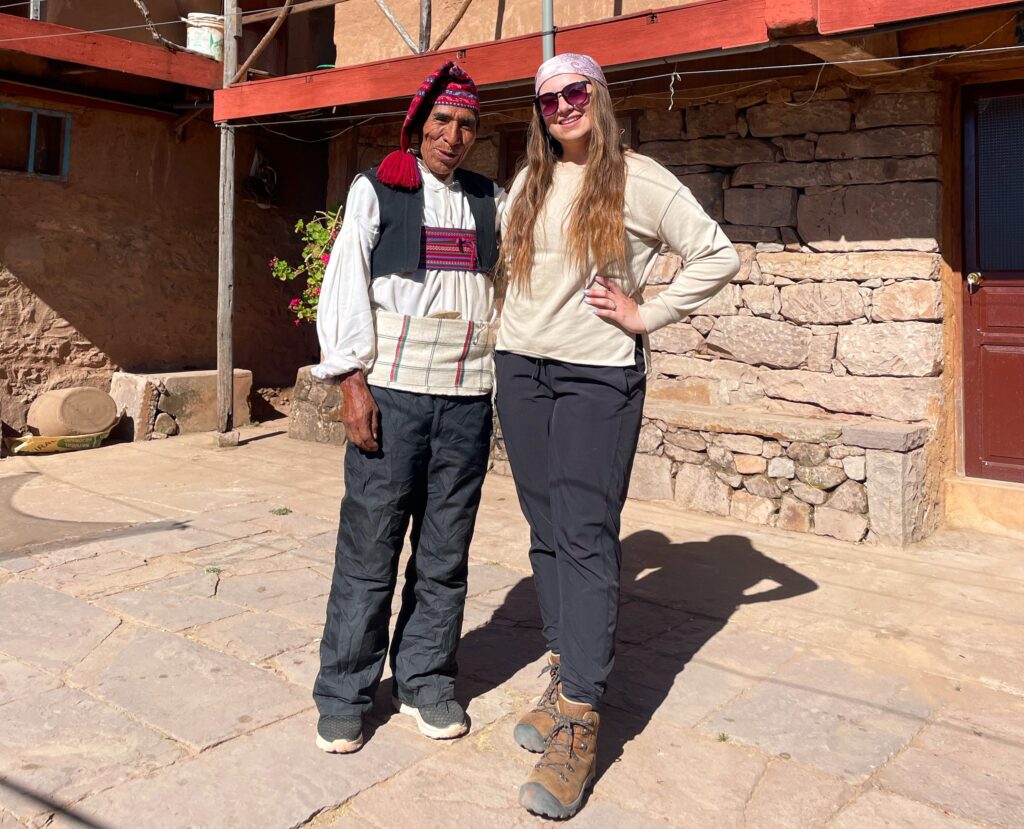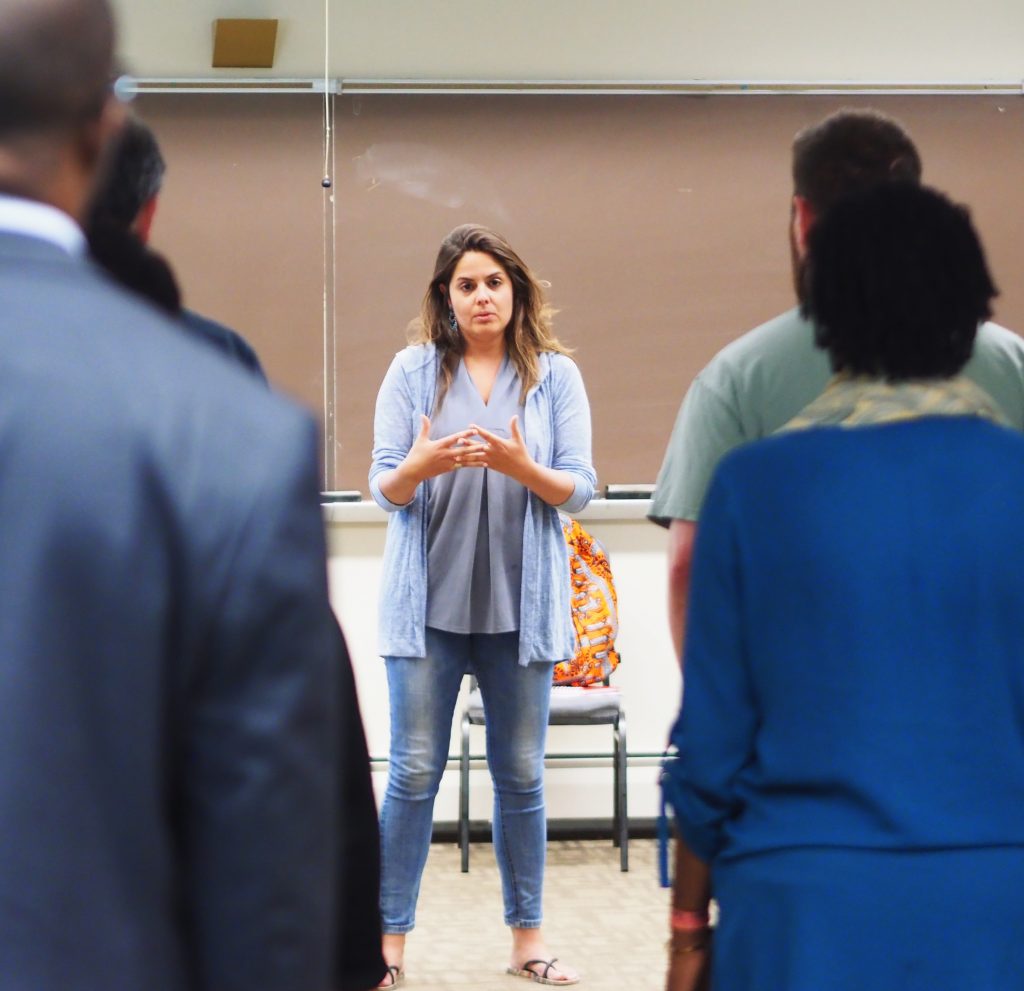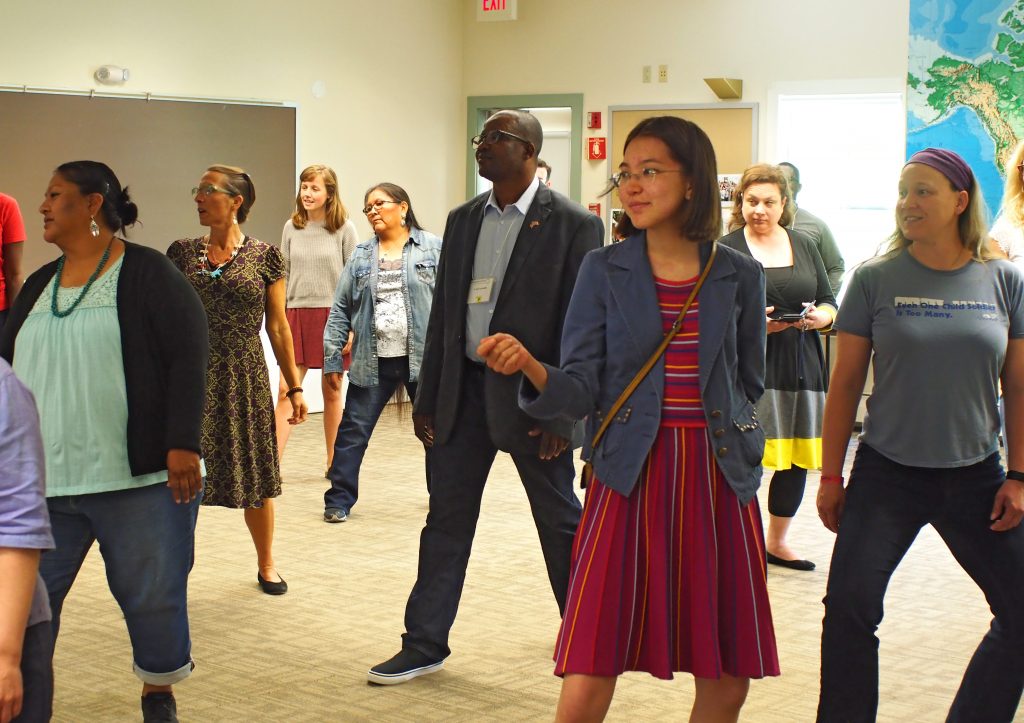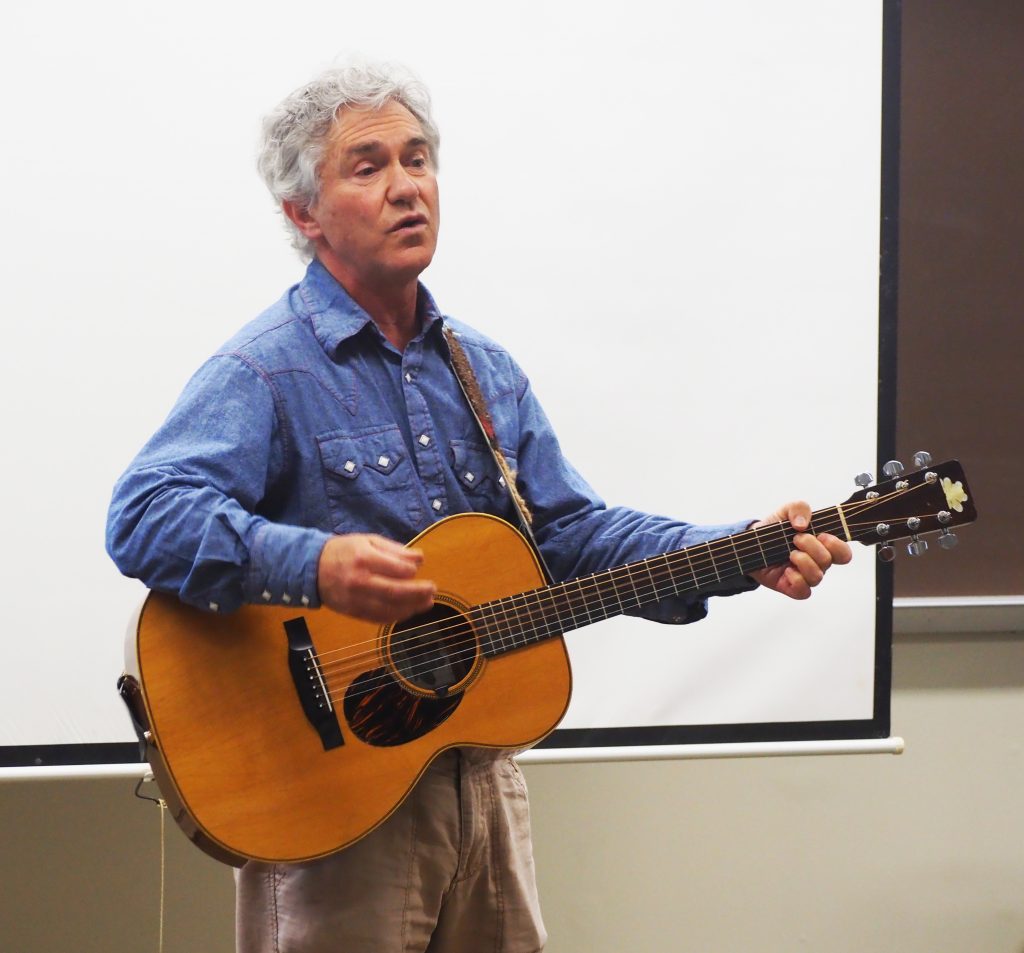‘Cultural, land-based knowledge and exchange programs helped me see my identity, my worldview’

As a member of Pine Creek First Nation in northern Manitoba, Canada, Brittany Lavallee wants to bring her academic interests in human rights and humanitarian assistance back around to her community.
A degree candidate in SIT’s Global Master’s in Humanitarian Assistance and Crisis Management, Lavallee worked with her program chair, Dr. Bayan Abdulhaq, to organize her practicum in Cusco, Peru, where she helped to develop a grants database for Peruvian Indigenous students to join the SIT Study Abroad program Indigenous Peoples and Globalization.
“As Brittany’s advisor, I realized her profound interest and passion relating to development and human rights of Indigenous people and thought Peru would be a perfect fit,” said Dr. Abdulhaq,
Lavalee is also developing a curriculum on empowerment in First Nations resilience and sustainability, which includes an educational exchange that takes Pine Creek First Nation high school students to Indigenous communities across Canada and South America.
I realized her profound interest and passion relating to development and human rights of Indigenous people …
Dr. Bayan Abdulhaq
Before coming to SIT, Lavallee earned a BA in human rights at the University of Winnipeg’s Global College. While there, she joined three community-based volunteer opportunities with Volunteer Eco Students Abroad. She also participated in a peace and conflict studies field course that took her to Israel and Palestine. For her practicum, she worked as a research writer at the Assembly of Manitoba Chiefs’ First Nations Family Advocate Office in Winnipeg.
That grew into a full-time job after university. Lavallee conducted and wrote research about birth alerts, in which Canadian family services agencies alert hospitals when a mother, who is often Indigenous, has aged out of care and/or has a history of substance abuse. The practice is less frequent now due to a 2019 national inquiry into missing and murdered Indigenous women that called for ending the discriminatory practice. However, Lavalee said apprehension of newborns still takes place in Manitoba, and advocates at the agency where she worked continue to intervene to keep newborns with their families, communities, and Nations.
We talked with Lavallee about the personal and academic path that brought her to SIT and where she plans to go next. Following are excerpts from that conversation, which have been edited for length.

Where is Pine Creek First Nation, and what is your connection?
Manitoba is in the center of Canada between Saskatchewan and Ontario. Winnipeg is our capital and has the biggest urban Indigenous population in Canada. There are 63 First Nations in Manitoba alone. My family is from Pine Creek First Nation, and I am a treaty member, meaning the government recognizes me as First Nation. I am registered to Pine Creek, where I am able to access supports and services obligated through treaty rights.
Has your personal and cultural background influenced your academic path?
I went to the University of Winnipeg a year after I graduated high school. I was a sponsored student through my First Nation, meaning they provided financial support while I was at university. You have to apply every year to be a sponsored student and make sure you have excellent grades and attendance. It’s a privilege for me because funding is not available for all First Nation students to be sponsored.
I first went into criminal justice thinking that I wanted to be a police officer. My dad worked for the Royal Canadian Mounted Police and at the time this was an amazing job opportunity for him at the age of 19, when he first left the reserve in search of more job opportunities. He was stationed in northern Manitoba in many small towns near the reserves, so that’s where I grew up. But when I started investigating the history of policing in Canada, I realized the RCMP was created to oversee Indigenous peoples and ensure they were going to residential schools. It’s a really ugly history, and there are still many issues between the RCMP and Indigenous peoples. I figured out it wasn’t my career path.
I started doing volunteering abroad with Volunteer Eco Students Abroad. I went to Ecuador for my first experience when I was 19. This was one of the first times I traveled outside of Canada, and it was pretty intimidating to go by myself. But ultimately, I loved my experience and wanted to volunteer again, so I went to Laos for the second program and then to Mozambique.
Then I thought, how can I have this experience with my university degree? I had heard about a human rights program offered through my university’s Global College, so I switched my major. Volunteering abroad helped me find my passions and what I wanted to do with my life.
Why did you choose SIT’s Global Master’s for your graduate school?
I was always interested in doing my master’s, especially as I met more people through the office where I worked who had their master’s degrees. Still, I wasn’t sure if I wanted to because school was kind of difficult for me—to be a First Nations person from Canada in this system that wasn’t really made for me. I have a lot of beliefs and traditions that contradicted history and some of the things I was learning. But I love learning and being in an educational setting, so I was searching online for a human rights master’s when I came across SIT. I knew this was the type of schooling that would be best suited for me: to hear from professionals from all walks of life, to travel and learn instead of always sitting in a classroom.
What drew you to the humanitarian assistance program?
Even though I wasn’t specifically interested in working with refugees, I thought it best fit with my undergraduate study of human rights. I was also interested in crisis management—learning to manage crises on different levels.
How did you decide to do your practicum in Peru?
One of the appeals of this program was that you could be in three different countries, all with different experiences. My program did our first semester in Jordan in the fall, then Serbia in the spring. Being in the Middle East and then the Balkans was nice, but I knew I wanted to do my practicum in South America. That was my goal from the very beginning. I wanted to do a practicum directly linked to Indigenous peoples globally.

I knew SIT had undergraduate programs in South America. I had a lot of help from my program director, Dr. Bayan, who communicated with the SIT academic director in Peru. We developed a plan of personal, professional, and institutional objectives to make sure that my interests for my future were met.
What did you do for your practicum?
In my program management course, I developed a proposal for my final project called Empowerment in First Nations Sustainability and Resilience. I created this so that students in grades 11 and 12 on the reserves would be able to have a more First Nations-based curriculum and travel and on exchange programs.
Many Elders had told me that our youth must return to our roots to heal and overcome barriers.
In Manitoba, graduation rates for Indigenous youth are 50 percent, compared to the graduation rate for non-Indigenous students, which is about 91 percent. This is predicted to be even lower for First Nations youth living in reserves. So, there’s a huge educational gap that Manitoba is trying to work on in its 2022 K-12 education action plan.
This project aims to close the education gap by offering a First Nations-based curriculum using the Medicine Wheel Pedagogy with land-based knowledge and seven field excursions. Many Elders had told me that our youth must return to our roots to heal and overcome barriers.
Another part of my practicum placement, which was very important for my personal objectives, was to learn about the logistics of running an exchange program like SIT’s.
[SIT Peru Academic Director Alex Alvarez] wants more Indigenous students from Peru to be in his program, to have the same opportunities as students from the United States. We decided I could assist with that by helping to develop a database that has grants and scholarships for the Indigenous students in Peru.

Can you describe an experience in Peru that was impactful for you?
I was in Peru for just over two month. While there, I went to Taquile Island in Lake Titicaca. It was extraordinary, and difficult to put into words how unique that experience was. They have their own community structure and leaders, which is very similar to the reserves in Canada. We have a chief and council. But in Peru, it’s very separate compared to our reserves, which work closely with the federal and provincial governments.
In Taquile Island, they talked about how the island was colonized a lot later than the rest of Peru and how they uphold their traditional ways. They’re able to sustain themselves with their own economy through tourism, textiles, and agriculture. They uphold their traditional values in how they operate their community with their own Knowledge Keepers and the whole community speaks their Indigenous language.
Next is your capstone. What are you working on?
The title of my capstone is Community Resilience and Building Capacities for Risk Reduction in First Nations Communities. It’s a case study in my Pine Creek First Nation.
I thought about how First Nations communities across Canada have demonstrated resilience to adapt and sustain their l livelihoods while keeping alive their traditional ways.
I’ve been learning about different humanitarian aid sectors, and about shifting the paradigm of immediate relief toward more long-term planning. Many humanitarian aid organizations deliver the necessary aid for the time being, but then it’s really hard for a community to recover and have access to long-term resources. So, there is a sector that is focusing on resilience and livelihood projects like agriculture and other areas that are needed for a community or a city to rebuild.
I thought about how First Nations communities across Canada have demonstrated resilience to adapt and sustain their l livelihoods while keeping alive their traditional ways. My chief and council have been so supportive of my education as a sponsored student, so I knew they would allow me to come into the community to do my data collection.
For my capstone, I’ll be looking into the mechanisms of community resilience from the perspective of the community members within the framework of specific social and environmental events. There were two major events that happened in Pine Creek in the past two or three years. They had a major flood, which knocked out one of the bridges in the community and separated everyone. There was also a fire that destroyed a lot of properties; people’s lives were at risk and the community had to be evacuated. This is something that has been getting worse every year in Canada due to harsh winters and dry summers. I am also exploring the lack of resources such as employment, which cause a lot of members to leave the reserve.
One of my specific objectives is to analyze this in relation to society and culture. I interviewed elders in the community and Knowledge Keepers to find out how they address disaster risk reduction.
It sounds like you could go in a lot of different directions with your academic focus and your research. Where do you see yourself going with this, both professionally and personally?
During Christmas break, I brought home my project proposal and I met with the chief and the council. They all really liked the idea, so the next step is to present this to the local school board so that they’re able to advocate for this course to the Frontier School division, which is the biggest school division in Manitoba, so the course can get accredited.
My goal professionally is to continue my work with Indigenous people in Canada and globally, if possible, to focus on moving this project forward. After this project is accredited, the funding must be figured out, and we want this course to be sustainable. Right now, it’s a pilot project, but if the course does go well and we can find different streams of funding, this will be closely monitored and evaluated. And then maybe this type of course can be offered in other schools in reserves.
So, it’s scalable.
Exactly. There’s nothing else offered like this in Manitoba, for students to be able to do this global exchange and meet other Indigenous communities. In this project they would go to Ecuador; I looked into working with an organization called the Naku Organization that offers tourism in the Sápara Nation. It’s quite isolated and they’re trying to raise money through tourism so their youth can go to post-secondary school. I would like for the youth in the reserve to go to the Sápara Nation to see the similarities and differences between the communities.
Cultural, land-based knowledge and exchange programs like this helped me see my identity, my worldview
It would be a short visit, 10 days. Also, the chief wants to take them to a community in British Colombia that is very prosperous and doing well. So, there might be two field visits out of the reserve. Most of the youth who would be in this program have never left the reserve.
What have these experiences meant to you?
Cultural, land-based knowledge and exchange programs like this helped me see my identity, my worldview, and also to meet different Indigenous communities, which is very important because there are so many valuable reflections. There’s so much we can learn from each other, and it is extraordinary to be able to travel to another community across the world. There’s a lot of this happening.
I feel that we focus a lot on the atrocities and the systems that fail us time and time again by society, and this is very heavy for First Nations communities. First Nations students must be reminded and feel empowerment because we are very resilient people and our cultures and beliefs have guided us through history.
How an award-winning SIT alum is reviving her Indigenous community
Dr. Sarah Wright Cardinal, an alumna of the MA in TESOL program at SIT Graduate Institute, has been awarded the 2022 Ehor Boyanowsky Academic of the Year Award from the Confederation of University Faculty Associations of British Columbia.
The award “celebrates faculty who contribute in significant ways to our citizenry and democratic landscape, our intellectual life, and our economy,” according to the organization’s website. It comes after a two-year canoe-building project that aims to bring more Indigenous content into course curriculum and research.
An assistant professor in the School of Child and Youth Care at the University of Victoria, Dr. Wright Cardinal is a Cree educator from northern Treaty 8 territory with Coast Salish, Dene, and Nuu-chah-nulth extended family relations. Her work explores colonial disruptions to Indigenous identities and addresses these fractures with land, water, and spirit-based teachings and practices that contribute to community wellness.
We’re healing from genocide and assimilative policies. So, it’s critically important to provide experiences for youth in their home communities. And we need our young men well for our communities to be well.
Dr. Sarah Wright Cardinal
Following are excerpts from a University of Victoria (UVic) article “Canoe creation re-awakens Pacheedaht ancestors” by Suzanne Ahearne. It delves into Dr. Wright Cardinal’s two-year project to document the carving of a 33-foot cedar canoe, and in the process reclaim Nuu-chah-nluth teachings, empower Pacheedaht youth, and build language, cultural mentorship, and wellness models for rural and remote Indigenous communities.

Dr. Sarah Wright Cardinal (center) stands with community members to receive gifts of drums in the canoe’s pre-launch ceremony.
Photo courtesy of Suzanne Ahearne/UVic
The idea—to involve a whole community in the carving of an oceangoing canoe, and surround it with the teachings and culture of their pre-colonial ancestors—was designed with young people in mind. The project aimed to revive confidence, health and well-being, and pride—in particular, among its young men—by creating a work of great physical and symbolic weight.
The canoe, which over the course of the four-month carving process “revealed itself as female,” is the centerpiece of a two-year project that emerged from and is led by the Pacheedaht First Nation (PFN), in partnership with UVic Child and Youth Care Professor Sarah Wright Cardinal. It is the first seaworthy dugout canoe to be carved in the community for more than 50 years.
“Reclaiming Nuu-chah-nulth teachings to empower and strengthen the roles and responsibilities of Pacheedaht young men,” is funded by a $200,000 grant from the Social Sciences and Humanities Research Council, a federal agency that supports post-secondary research. This partnership is UVic’s first memorandum of understanding with the PFN, one of 12 First Nations with reserves in the Capital Regional District.
This is a ceremonial, education and community wellness journey. And it’s a necessary part of child and youth care today.
Dr. Sarah Wright Cardinal
“We’re healing from genocide and assimilative policies,” says Cardinal, who is Cree from Treaty 8 territory and has a PhD from UVic in curriculum and instruction. “So, it’s critically important to provide experiences for youth in their home communities. And we need our young men well for our communities to be well.”

Photo courtesy of Suzanne Ahearne/UVic
Asked how this type of academic research and partnering differs from traditional research, Cardinal says it’s not what many think of as scholarly work. “This is a ceremonial, education and community wellness journey, and it’s a necessary part of child and youth care today.”
“Everything stays in community. This respects the intellectual property of Pacheedaht and Nuu-chah-nulth teachings. The ancestral and local land and water-based knowledge is enlivened at home in the village, nurturing strong kinship family systems.”
Cardinal sees part of her role as a conduit to knowledge-sharing back to the university community: to bring Indigenous content into course curriculum as well as into research, and model “ethical, responsible, Indigenous research.”

Every summer, an international group of peacemakers gathers on the SIT campus in Vermont. They learn from faculty, but they also learn from the often remarkable experiences of their fellow students.

Participants in CONTACT — Conflict Transformation Across Cultures — spend two weeks in Vermont, taking core and elective courses and simply getting to know each other. Many spend a third week in Washington, D.C.

CONTACT classes get down to serious business, discussing intractable conflicts and the details of developing dialogue even in such difficult circumstances. But classrooms often emit sounds of music and laughter — participants lead exercises aimed at shared sense of purpose and cross-cultural understanding before the hard work begins.


Abel Learwellie came to CONTACT to enrich his knowledge of the work he’s already doing as executive director of the Camp for Peace Liberia, which brings together youth to learn about non-violent conflict resolution and peace education. “Everything we do here is practical, which leaves a very good imprint on your mind. I’ll be able to apply these practical concepts in my day-to-day work,” he says.
Learwellie particularly enjoys the opportunities to exchange ideas with peers from across the world — including Rwanda, Spain, the U.S., and Canada — who have different experiences and perspectives on peace and conflict transformation. “Everyone is bringing their experiences,” he says. “I’m learning a lot from my peers and they’re also learning from me. It’s give and take.”

Some CONTACT participants are new to the field of peacemaking, or come to the program to augment work they do in other fields. Others, like Learwellie, arrive with careers in the field well underway.

Conflict transformation is at the heart of Johnson Mugaga’s role at the National Unity & Reconciliation Commission of Rwanda, established to unite the country in the aftermath of that country’s 1994 genocide. As division manager in charge of programs, he often works with researchers and experts, and wanted to gain a better understanding of their technical knowledge. “The best place to get it is CONTACT,” he says.
Not only is the program giving him better insight into his work, but Mugaga says the scenic peace of the SIT campus has been very conducive to learning. “It’s a good environment for anything academic,” he says.

Another of this year’s participants is Kerry Ryer-Parke, who teaches voice at Bennington College in Vermont. Though at first glance it may seem unusual for a music teacher to study peacebuilding, it’s a natural progression for Ryer-Parke.
“I believe in music as a community-building activity. I’m looking to design courses that combine music and peacebuilding,” she says.
The organization Musicians Without Borders is also a key part of the CONTACT program, offering electives in just this sort of combination. Ryer-Parke says she’s found that their work has offered her a well-researched foundation for things she, as a music teacher, already found herself understanding on a more intuitive, instinctual level.
“They’ve discussed how trauma interferes with things like cognition. And music has the ability to bring the brain back into function because it uses the body, it uses rhythm, it uses both hemispheres of the brain.”
Echoing the sentiments of many students, Ryer-Parke adds that her time on campus has proven fruitful not solely because of academic work, but in part because of the opportunity to get to know people from different backgrounds and cultures.

